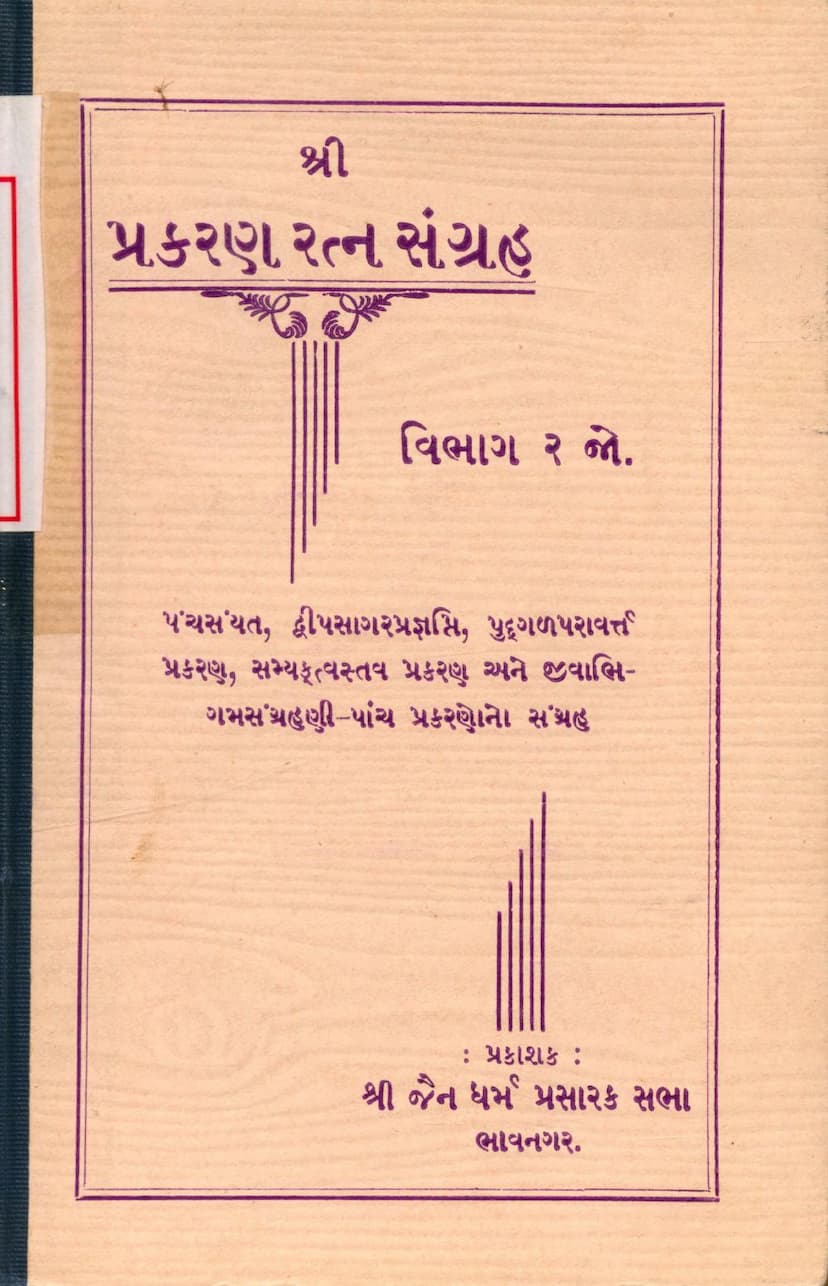Prakaran Ratna Sangraha
Added to library: September 2, 2025

Summary
Here's a comprehensive summary of the Jain text "Prakaran Ratna Sangraha, Vibhag 2," based on the provided pages:
Book Title: Prakaran Ratna Sangraha (Collection of Gem-like Chapters) Section: Volume 2 (Vibhag 2) Publisher: Shri Jain Dharm Prasarak Sabha, Bhavnagar Date of Publication: Vikram Samvat 1997 (Veer Samvat 2467)
This volume is a compilation of five important Jain chapters, prepared and published by the Shri Jain Dharm Prasarak Sabha in Bhavnagar. It is dedicated in memory of Sadhviji Labhashriji, whose family and disciples inspired its creation. The Sabha has a history of publishing various scriptures, and this volume is presented as a significant contribution in her remembrance, containing "highly necessary and previously unpublished" five chapters.
The Five Chapters Included:
-
Shri Panch Samyat Prakaran:
- Authored by Pandit Shri Jeevavijayaji.
- Consists of 106 verses (Gathas).
- Based on the 7th chapter (Udesha) of the 25th chapter (Shvetaka) of the Shri Bhagavati Sutra.
- Details five types of disciplines (Samyat) like Samayik, with 36 "doors" (Dwar – aspects/categories) explained for each.
- The introduction notes that initially, the author was unknown, leading to its compilation in Gujarati. Later, a commented manuscript was found and is presented here with its commentary.
- Considered highly useful for monks, offering deep insights through its study.
-
Shri Dwip Sagar Pannatti Sutra:
- A chapter-like scripture with 220 verses.
- Requires significant effort due to inaccuracies found in existing manuscripts. Despite consulting four copies, a pure version was elusive, leading to the preparation of a purified version based on understanding, with clarifications provided where explanations were uncertain.
- Describes the geography from the Manushottara mountain to the Chakrakundali sea.
- Contains new and noteworthy information, including:
- The consistent depth of 1000 Yojanas for all oceans between islands, similar to the Lavana sea, with a Jagati of 95,000 Yojanas on both sides.
- Details about capitals, cities, and "utpaat sthan" (places of origin/emergence) for various deities across different islands and oceans.
- Specific numbers of capitals for Indra Shakra (84,000) and Ishana (80,000) among their Samanika deities.
- Mentions the capitals of other Lokapalas and Trayastrimsha deities.
- Describes the locations of 40 Disha Kumarikas on the Chakrakuta island.
-
Shri Pudgal Paravart Prakaran:
- A chapter of 11 verses with commentary.
- Explains the nature of Pudgal Paravarta in four aspects: Dravya (substance), Kshetra (space), Kala (time), and Bhava (state).
- Also describes eight types of Pudgal Paravarta, combining subtle and gross forms.
- Includes the meaning of the original verses.
- Considered a small but very useful and understandable chapter.
-
Shri Samyakttva Stav Prakaran:
- A chapter of 25 verses with commentary.
- Clearly explains the nature of Samyaktva (Right Faith) and its five classifications.
- This chapter was previously published with detailed explanations in the first volume of Prakaran Ratna Sangraha. This volume presents the Gujarati meaning of its 25 original verses.
- Described as particularly worthy of study.
-
Shri Jivabhigam Sangrahani Prakaran:
- A chapter of 220 verses with meaning.
- Focuses on the first "pratipatti" (classification/understanding) of the nine regarding souls (Jiva) presented in the Jivabhigam Sutra.
- Details the two types of souls: Jivas (mobile) and Sthavaras (immobile).
- Explains the sub-types of Sthavaras (Earth, Water, Fire, Air, Vegetation) and Jivas (two-sensed to five-sensed), detailing 23 "doors" (aspects) for each.
- The 24th "door" concerning the number of these souls is also included.
- Contains much noteworthy information that warrants careful reading and consideration.
- Highlights specific distinctions from the commonly understood form of Jiva classification, advising readers to refer to the chapter itself for these nuances.
- The preface also briefly outlines the subjects of the other eight "pratipattis" in the Jivabhigam Sutra, indicating that similar chapters covering these might exist but were not available for this compilation.
Acknowledgments and Gratitude: The publication acknowledges the invaluable contribution of various scholars and monks:
- Muni Shri Punyavijayaji from Patan for sending the press copy of the third and fourth chapters.
- Pandit Shri Gambhirvijayaji Maharaj for providing the commented manuscript of the first chapter.
- The manuscripts of Dwip Sagar Pannatti were received from Acharya Shri Vijayanemisuri, Acharya Shri Vijay Mohansuri, Acharya Shri Vijay Siddhisuri, and Pravartak Kantivijayji Maharaj.
- The manuscript for Jivabhigam Sangrahani was also received from Pravartak Shri Kantivijayji Maharaj.
The Sabha expresses gratitude to all those who helped in obtaining these ancient texts.
Errata and Apology: A list of corrections (Shuddhipatra) is provided for printing errors. The publishers also offer an apology for any inaccuracies or deviations from scriptures in the explanations, attributing them to inadvertent mistakes during the writing process.
About Sadhviji Labhashriji: A brief biography of Sadhviji Labhashriji is mentioned as being included in the beginning of another book, "Shri Laghu Kshetra Masni." A list of scriptures published through her efforts is available in the "Laghu Chovishi Vishishti Sangrah."
Genealogy of Sadhvis: Page 10 provides a detailed genealogy of the lineage of Sadhvis, tracing back from Guruni Vivekshriji through Gulabshriji to Labhashriji, and listing her disciples and their subsequent disciples, indicating those who have attained liberation with a '+' sign.
In essence, "Prakaran Ratna Sangraha, Vibhag 2" is a scholarly collection aiming to preserve and disseminate five significant Jain philosophical and cosmological treatises, honoring a revered spiritual figure while ensuring the availability of these texts for study and spiritual edification.